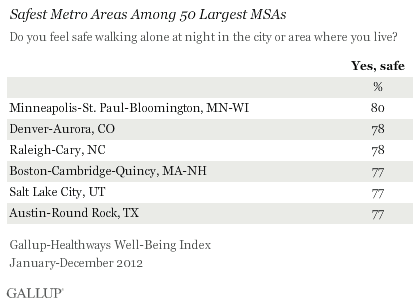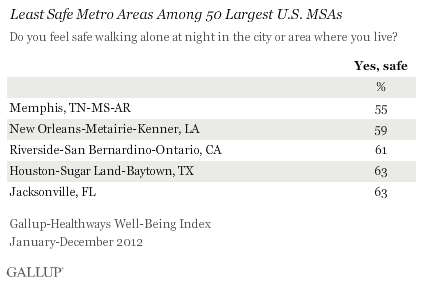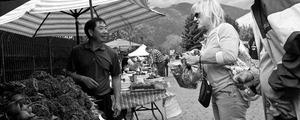PRINCETON, NJ -- Eighty percent of those living in the Minneapolis-St. Paul area say they feel safe walking alone at night in the area where they live, the highest percentage among the 50 largest U.S. metropolitan areas. Minneapolis is followed closely by Denver, Raleigh, Boston, Salt Lake City, and Austin.

There is wide variation among the largest metro areas in residents' self-reported security. Memphis area residents are the least likely to say they feel safe walking alone at night, at 55%. Fewer than six in 10 New Orleans area residents feel safe at night in their local area, as well. Riverside, Calif.; Houston, Texas; and Jacksonville, Fla., are also among the least safe cities according to resident reports.

The data are based on Gallup-Healthways Well-Being Index data collected throughout 2012. Each night, Gallup asks Americans whether they "feel safe walking alone at night in the city or area where you live?" Gallup compiled the data for residents of the 50 most populous Metropolitan Statistical Areas and weighted each sample to make sure it was demographically representative of that MSA. The full data on each MSA can be found on page two.
The average level of perceived safety among those living in the largest MSAs is 71%. The national average is slightly higher, at 72%.
Though crime statistics are not available for all MSAs, there is a strong negative correlation (-.64) between the FBI's 2010 violent crime rate for an MSA and the percentage of the MSA residents who report feeling safe -- with the cities where residents feeling safest having lower crime rates, and vice versa. Although the FBI crime rates may not be directly comparable across areas, Memphis had by far the highest violent crime rate among the 50 largest MSAs for which data were available. The FBI data did not estimate a violent crime rate for Minneapolis.
Local citizen's feelings about safety are fairly stable; compared with 2011, the average change in the percent feeling safe was one percentage point in either direction. As a result, the safest and least safe cities changed little. In 2011, Minneapolis and Boston tied with the highest percentage of residents saying they feel safe walking alone at night at 79%, followed by Raleigh and Austin residents at 77%. The least safe metro areas were Memphis (60%), Riverside (61%), New Orleans (63%), and Houston (63%).
Implications
Minneapolis-St. Paul area residents have the highest sense of personal security among Americans living in the nation's top metro areas, at least in terms of feeling safe walking alone at night in their local area. While the rank order of the top 50 on this measure may differ somewhat from other rankings of city safety, it nevertheless offers an important perspective on one aspect of how crime affects people's lives.
FBI 2010 violent crime statistics were not available for Minneapolis, so it is not possible to know if their residents' high sense of security comports with reality, but in general, areas that have lower violent crime rates tend to have a higher percentage of residents saying they feel safe. Denver, Raleigh, Boston, Salt Lake City, and Austin metro area residents also express a high degree of personal security.
On a relative basis, Memphis residents are the least likely to express a feeling of safety in their local area, consistent with the high crime rate in the Memphis area. Still, more than half of Memphis residents, 55%, say they feel safe.
By definition, the Metropolitan Statistical Areas include both a central city and suburban areas, and certainly residents in parts of lower-ranked metro areas may feel very safe, while those in certain parts of other highly ranked metro areas may feel very unsafe. Gallup data do not allow for such a fine-tuned analysis. Nevertheless, these MSA-level data provide a general overview of the perceived safety of the largest metro areas.
About the Gallup-Healthways Well-Being Index
The Gallup-Healthways Well-Being Index tracks well-being in the U.S. and provides best-in-class solutions for a healthier world. To learn more, please visit well-beingindex.com.
Survey Methods
Results are based on telephone interviews conducted as part of Gallup Daily tracking Jan. 1-Dec. 31, 2012, with random samples of adults, aged 18 and older, living in the 50 largest Metropolitan Statistical Areas by population.
Margins of error for individual MSAs are no greater than ±4 percentage points, and are ±3 percentage points in most MSAs.
Interviews are conducted with respondents on landline telephones and cellular phones, with interviews conducted in Spanish for respondents who are primarily Spanish-speaking. Each sample includes a minimum quota of 400 cellphone respondents and 600 landline respondents per 1,000 national adults, with additional minimum quotas among landline respondents by region. Landline telephone numbers are chosen at random among listed telephone numbers. Cellphone numbers are selected using random-digit-dial methods. Landline respondents are chosen at random within each household on the basis of which member had the most recent birthday.
Samples are weighted by gender, age, race, Hispanic ethnicity, education, region, adults in the household, and phone status (cellphone only/landline only/both, cellphone mostly, and having an unlisted landline number). Demographic weighting targets are based on the March 2011 Current Population Survey figures for the aged 18 and older non-institutionalized population living in U.S. telephone households. All reported margins of sampling error include the computed design effects for weighting.
In addition to sampling error, question wording and practical difficulties in conducting surveys can introduce error or bias into the findings of public opinion polls.
For more details on Gallup's polling methodology, visit https://www.gallup.com/.

